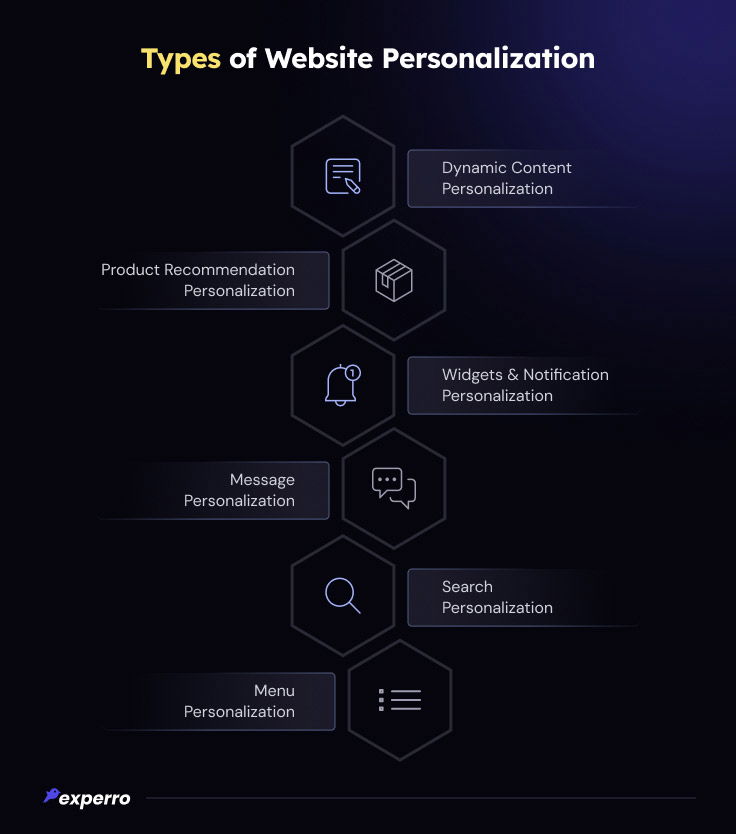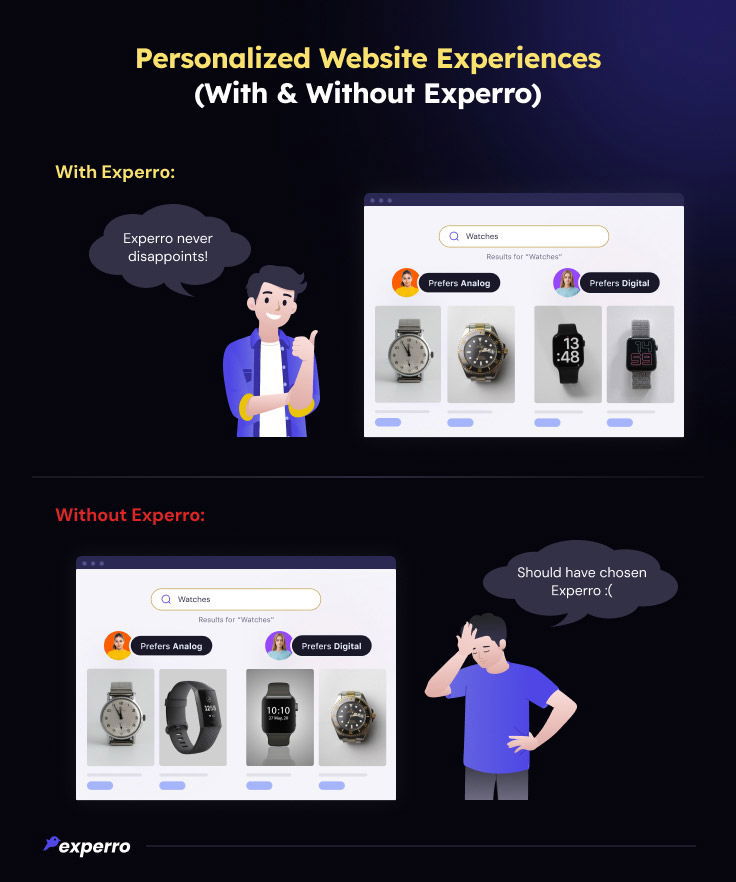- Blog
- Personalization
- eCommerce
- 7 min read
Try These Types of Website Personalization to Amaze Customers!
Published
10 September 2024Updated
2 September 2025

Key Takeaways
- Understanding the types of website personalization is essential for creating tailored user experiences that drive engagement and conversions.
- Advanced personalization techniques, like menu and search personalization, can significantly improve user navigation and overall site efficiency.
- Implementing content, product recommendation, widgets & notifications, personalized messages, search and menu personalization in your website personalization ideas can enhance user engagement and provide a tailored, relevant experience for every visitor.
- Experro offers cutting-edge features and strategies to implement real-time, personalized web experience that maximizes business success.
How do some websites know exactly what you want as soon as you land there?
Are they into spooky stuff? Lol, no! They have understood what is personalization, its bright future and have executed it successfully.
Nowadays, implementing types of website personalization has become a key strategy for businesses aiming to enhance user’s website experience and boost conversion rates.
It’s also a proven method for increasing website personalization ROI by aligning user preferences with tailored content.
This approach increases user satisfaction, drives significant returns on investment (ROI), and has a lot more benefits of website personalization.
As technology evolves, so do the methods and website personalization strategies. Let's discuss the personalization of a website.
What is Website Personalization In eCommerce?
Website personalization definition - Website personalization at scale is customizing a website’s content and layout to match individual users' preferences, behavior, and needs.
Businesses can create personalized web experiences that resonate with each visitor by leveraging data.
Research reveals that 71 percent of consumers expect companies to provide personalized interactions.
These site personalization efforts go beyond generic content, making the user feel valued and understood, which can lead to higher engagement and conversion rates.
Now, let’s explore some website personalization types.
What Are the Types of Website Personalization?
A complete website or a homepage personalization can take many forms, each designed to enhance the customer experience in a unique way.

Below are some of the most effective types of website personalization in eCommerce:
1. Dynamic Content Personalization
Dynamic website content personalization refers to the practice of updating website content in real-time based on user data such as behavior, location, and preferences.
This strategy allows for the delivery of personalized web page content that resonates with the individual customer, leading to a more engaging website experience.
Dynamic website personalization solutions help in boosting customer engagement and conversion rates by providing relevant content at the right time. By using a headless CMS, businesses can easily deliver this personalized content across various channels and devices.
This kind of customization is crucial for delivering website personalization ROI, as it ensures that every visitor receives content tailored to their specific interests.
For example:
A personalized homepage might display different banners or offers based on whether the visitor is a new or returning customer.
2. Product Recommendation Personalization
Product recommendation personalization is effective, especially when integrated with eCommerce search personalization.
By analyzing a visitor's behavior like browsing history and past purchases, websites can suggest products that the user is likely to be interested in.
This type of hyper-personalization not only enhances the shopping experience but also increases average order value and customer satisfaction.
Product recommendation personalization can be seen on product pages, product listing page personalization, and even within personalized CTAs, where profile-based recommendations are tailored to each user.
The use of a website product personalization engine enables businesses to refine these recommendations further. This ensures they are always relevant and timely, which can significantly improve conversion rates.
Leveraging user behavior, such as browsing or purchase history, allows you to suggest products that match their interests, increasing engagement and purchase likelihood.
For example:
We often see this while browsing eStores - "You might also like these handpicked items based on your recent browsing."
3. Widgets & Push Notification Personalization
Personalized widgets and notifications are another way to enhance user engagement. This is one of the impactful categories of web personalization.
These can include personalized popups, push notifications, and other on-page elements that are tailored to the user’s behavior and preferences.
This digital personalization strategy helps in driving conversions by delivering relevant content.
Additionally, these website personalization popups can be used to re-engage website visitors who might otherwise leave the site, offering them reasons to stay and complete their purchase.
For instance:
A returning visitor might see a personalized CTA encouraging them to pick up where they left off, or a popup personalization offering a special discount to the customers based on their browsing history.
4. Message Personalization
Message personalization at scale involves tailoring communication to resonate more with the user.
This could be through personalized marketing campaigns, chatbots, or on-page messages that greet users by name or reference their past purchases.
Message personalization can significantly improve the user’s experience by making them feel recognized and valued, which is crucial for building long-term existing customer relationships.
Integrating omnichannel personalization ensures that these personalized promotions and messages are consistent across all platforms, enhancing the overall customer journey.
Personalize page or message with a user's name or reference to their past actions can make them feel acknowledged and engaged from the moment they interact with your platform.
For example:
"Hey Alex, welcome back! Ready to explore more of your favorites?"
5. Search Personalization
eCommerce search personalization is particularly impactful in enhancing user experience and driving higher conversions.
This ensures that users find what they’re looking for faster, enhancing their overall experience on the site.
Incorporating personalized search eCommerce capabilities can significantly reduce the time users spend searching, leading to higher satisfaction and conversion rates.
Tailoring search results based on a user's previous searches or purchase history helps them find relevant products faster, improving their overall shopping experience.
For instance:
"Based on your last search, here are some new arrivals just for you."
6. Menu Personalization
Menu personalization involves customizing the website’s navigation menu to reflect the user’s preferences and browsing behavior.
This could mean highlighting certain categories or products of interest to the user, thereby making the site easier to navigate.
Generative AI for personalization improves customer experience by making it simpler and quicker for visitors to find what they’re looking for, thus increasing the likelihood of conversion.
A personalized menu can also adapt over time as it learns more about the user’s preferences, making each visit more intuitive and user-friendly.
By customizing the navigation menu according to the user’s preferences, you make it easier for them to access the most relevant categories and products.
For example:
"Discover trending styles in your preferred categories, easily accessible in the menu."
For more details on the importance of website personalization, read our detailed guide on ‘website personalization statistics’.
Is Experro the Ultimate Solution for Personalized Web Experiences?

Experro is a robust platform for personalized website experiences that drive engagement and conversions.
With features like AI-powered search, dynamic headless content management, and personalized web page templates, Experro helps businesses implement effective strategies for website personalization.
The platform’s ability to leverage customer data for real-time website personalization makes it an ideal choice for businesses looking to enhance their enterprise website personalization strategy.
Experro’s eCommerce merchant intelligence allows businesses to tailor product displays and relevant recommendations, ensuring that each visitor sees the most relevant products, which can significantly boost sales and customer satisfaction.
Whether you're looking to personalize your homepage, landing pages, CTAs, or product recommendations, Experro’s eCommerce personalization software turn every digital interaction into a conversion opportunity!
Want to boost customer engagement? Choose Experro for unbeatable web personalization!
Conclusion
Personalizing your website is no longer optional; it’s a necessity for businesses looking to thrive in the digital marketplace.
By understanding and implementing the different types of website personalization, businesses can significantly improve customer engagement, satisfaction, and ultimately, ROI.
With platforms like Experro, creating personalized web experiences that resonate with your audience has never been easier.
Embrace website personalization best practices and watch your website transform into a dynamic, user-centric platform that drives results.
FAQs
What is personal personalization?
Personal personalization efforts refer to the practice of tailoring content or experiences specifically to an individual customer based on their unique preferences, behavior, and customer data.
It aims to create a more engaging and personalized experience for the user.
What is the difference between person-centered thinking and personalization?
Person-centered thinking focuses on better understanding and respecting the individual’s preferences, needs, and values in decision-making processes.
On the other hand, personalization specifically refers to personalized content or experiences to match those preferences in digital contexts, such as websites or marketing materials.
What are SaaS website personalization examples?
Website personalization use cases include:
- Product Recommendations: Displaying personalized product suggestions based on a user's browsing history or previous purchases.
- Dynamic Content: Changing website content, such as headlines or images, to match the user's preferences or location.
- Personalized Discounts: Offering special discounts to users based on their shopping behavior or cart value.
- Targeted Pop-ups: Showing pop-ups that align with the visitor's interests or current page behavior.
- Custom Landing Pages: Directing users to landing pages tailored to their previous interactions or demographics.
What is personalization of a website?
Website personalization is the process of tailoring content and user experiences based on individual visitor preferences, behaviors, and needs.
This helps create more relevant interactions, improving engagement and conversions. By using data, websites can deliver customized content to each user in real time.
Pallavi Dadhich
Content Writer @ ExperroPallavi is an ambitious author recognized for her expertise in crafting compelling content across various domains. Beyond her professional pursuits, Pallavi is deeply passionate about continuous learning, often immersing herself in the latest industry trends. When not weaving words, she dedicates her time to mastering graphic design.


